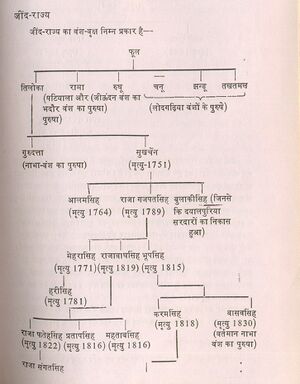Tiloka



Tiloka (तिलोका) is a gotra of Jats. [1]
The eldest son of Phul
Tiloka (b.-d.1687) of Siddhu-Barad Jat clan was eldest son of Phul.
The Originator of the Phulkian Dynasty, Phul of Siddhu-Barad Jat clan, left six sons, of whom Tiloka was the eldest, and from him are descended the families of Jind and Nabha.[2]
From Rama, the second son, sprang the greatest of the Phulkian houses, that of Patiala besides Bhadaur, Kot Duna and Malaudh .[3]
In 1627 Phul founded and gave his name to a village which was an important town in the State of Nabha. His two eldest sons founded Bhai Rupa while Rama also built Rampura Phul.
Claiming descent from Jaisal, founder of the State of Jaisalmer in 1156, the founder of this Jat Sikh dynasty, Phul, was Chaudhri (Governor) of a country located at the south east of Delhi.
Phul’s descendants founded 3 States: Patiala, Jind and Nabha.
Nabha was a state of Siddhu Jats founded by grandson of Chaudhary Phul Singh in 1755.
जाट इतिहास:ठाकुर देशराज
तिलोका पटियाला-स्टेट एवं जींद-स्टेट दोनों राजवंश का पुरखा और चौधरी फूल का पुत्र सिद्धू गोत्र का जाट था। जाट इतिहास:ठाकुर देशराज (पृ.476) से इनका इतिहास नीचे दिया जा रहा है।
चौधरी फूल के बड़े लड़के तिलोका के दो पुत्र हुए- गुरुदत्तसिंह और सुखचैन। बड़े भाई गुरुदत्तसिंह के वंशज नाभा-स्टेट और छोटे भाई सुखचैन के रियासत जींद, सरदार बड़रूखां व बाजेदपुर थे।
अपने पिता के पश्चात् तिलोका को चौधरायत मिली, परन्तु वह इतना होशियार न था कि रियासत की उन्नति करता।
तिलोका का दूसरा बेटा सुखचैन जिसके वंशज जींद स्टेट के राजगान थे, एक जमींदार की हैसियत से था। इसकी शादी मंडी गांव के एक जाट के यहां हुई थी। इसने अपने नाम पर एक गांव भी बसाया था, जो अपने छोटे बेटे बुलाकीसिंह को दिया था। इस तरह के बटवारे के पश्चात् वह अपने बेटे गजपतसिंह के साथ गांव फूल में रहा करता था और सन् 1751 में 75 वर्ष की उम्र में देहान्त हो गया।
सुखचैन का विशेष इतिहास नहीं मिलता। इसके तीन लड़के थे - आलमसिंह, गजपतसिंह और बुलाकीसिंह। आलमसिंह से इस स्टेट का इतिहास पूरा मिलता है।
Distribution
Notable persons
References
References
- ↑ O.S.Tugania:Jat Samuday ke Pramukh Adhar Bindu,p.43,s.n. 1130
- ↑ Latif, S.M., History of the Punjab
- ↑ A collection of treaties, engagements, and sunnuds, relating to India By India Foreign and Political Dept, Charles pp.274
Back to The Rulers

